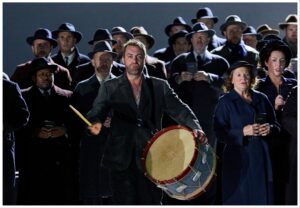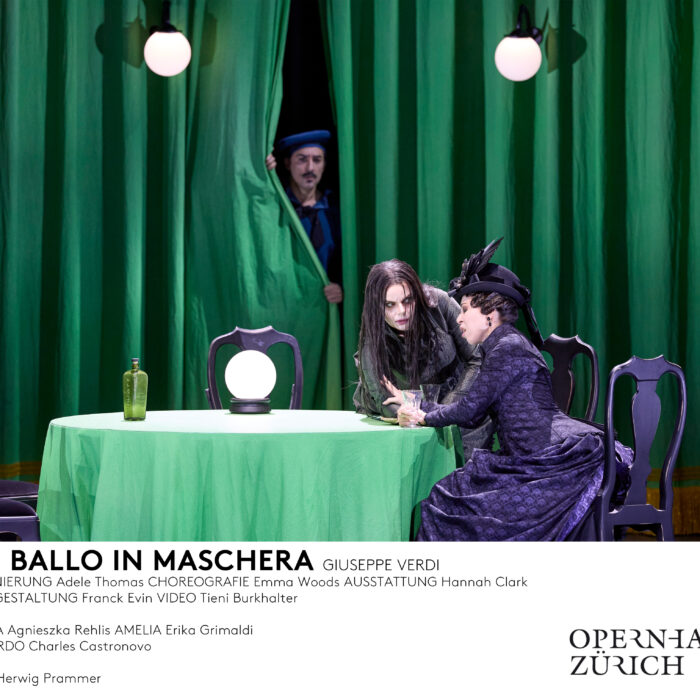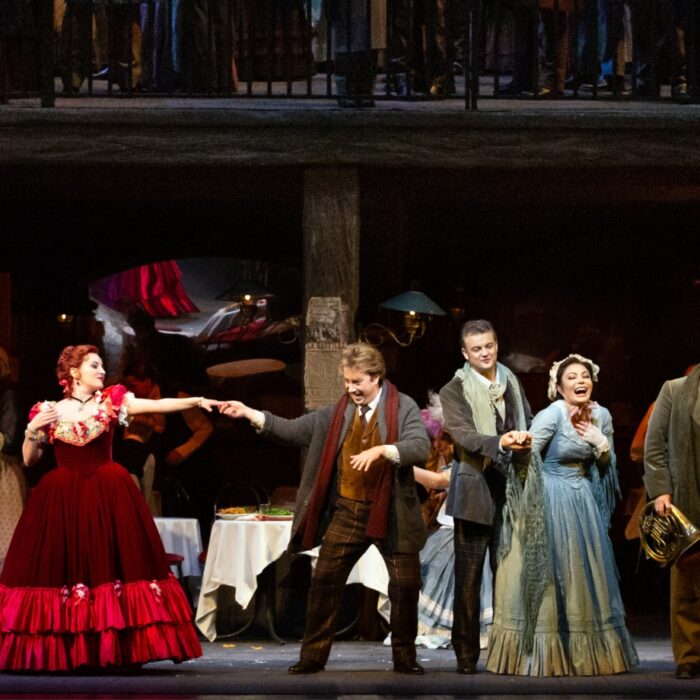
English National Opera 2023-24 Review: Peter Grimes
ENO’s New Season Opens with Searing Revival of Alden’s Expressionist Vision of Britten
By Benjamin Poore(Photo: ENO’s Peter Grimes 2023 © Tom Bowles)
David Alden’s “Peter Grimes” begins with the curtain up. Upstage the people of the Borough mill about restlessly, occasionally breaking into shouts of anger and impatience. Alden’s 2009 production, on its second revival, breaks with any wistful or bucolic notions about the seaside community of the Borough, who drive the equally unrelenting Grimes to his death.
This version of Britten’s 1945 opera, with text by Montagu Slater of George Crabbe’s poem “The Borough”, has generated strong reactions from critics and audiences since its debut, but also prompted some of the most hair-raising performances the Coliseum had seen in recent years, notably from former music director Edward Gardner and in tenor Stuart Skelton. For this season-opening production the orchestra is helmed by music director Martyn Brabbins, with the lead role sung by Gwyn Hughes Jones, familiar to the house as Cavaradossi, Radames, and David in Meistersinger.
Sets and design, by Paul Steinberg, are all sharp corners and bare metal, set in a postwar Britain made desperate by rationing and war. There are signs of trauma – abuse, air raids, or evacuation, perhaps all three – in the jerky, mechanistic movements of Auntie’s horror-movie nieces; Balstrode, in naval uniform, has only got one arm. The atmosphere is desperate and feral, especially in the garish party scene that opens Act three, like the dying days of the Weimar republic. Characterization is extreme, even grotesque, with pub landlady Auntie straight out of Otto Dix. Grimes himself is played on the brutal side, as unyielding as the great storm he endures in Act one, though sometimes some humanity slips through the cracks in his tough exterior, such as the way he trembles and stutters in the opening inquest.
The sea itself, in the piece, seems a kind of Freudian death drive, spurring the residents of the Borough to a sort of wild dance during the storm; Ellen Orford basks in its awesome, invigorating glory on Sunday morning. It is an elemental force both creative and destructive, and many times removed from the petty, hypocritical morality of the community. Grimes’ hut is a steeply-raked platform, placing him on a kind of psychic precipice. When the breakdown finally comes the stage is totally bare, apart from the gray flat horizon of Britten’s Suffolk coast. It gives ample room to let Britten’s extraordinary vocal writing sing for itself, but also shows us someone completely reduced to a psychological state of nature by people and events.
Not everything convinces. Some of the caricatures chill the blood – the nieces in particular – but others are overdone – the drunken preacher Bob Boles humping the leg of a terrified Mrs. Sedley and the music-hall prancing of Ned Keene both feel bathetic rather than calculated. The spare design doesn’t always dovetail with the text – the precipice around Grimes’ hut that the villagers have to cross is invisible and requires them to scramble up oddly onto a platform.
The expressionist visual language intensifies the work’s connections to Berg’s “Wozzeck”, an enormous influence on Britten in the writing of the opera. Furthermore they disintegrate any illusions about where fascist attitudes towards outsiders can take hold, especially ironising Britain’s idealized view of itself in the postwar period with its absurd figure of Britannia in Act three’s beauty pageant – something reflected in Britten’s own ambivalence, as a pacifist, about Britain itself. At the climax of the great Act three choral frenzy, Alden has the Borough folk waving Union Jacks, as if in some ghastly evocation of a VE Day celebration. It’s not subtle, but it is potent – the very thing that bonds communities so tightly in times of stress can also generate the most ferocious violence: “Him who despises us / We’ll destroy,” the chorus sing.
That violence is exemplified in unsparing singing from the ENO chorus, who are packed into a teeming obliquely-angled wedge for amazingly concentrated cries of “Peter Grimes,” in Act three, or elsewhere comes so close to the edge of the stage they are practically falling into the orchestra. The accusation made to the audience – there but for the grace of God go you – feels unshakeable.
Despite an extensive ensemble, everything ultimately rests on the title role. Gwyn Hughes Jones offers a distinctive entry among recent exponents, including Stuart Skelton and the remarkable, experimental Allan Clayton last year at the Royal Opera House. Fresh from “Tristan und Isolde” at Grange Park Opera this summer, he brings Wagnerian heft to the role, with a tightly-wound, focused sound that is the perfect vessel for a character constantly on the verge of an explosion; there was a fearlessness and fury to the character in his taut, narrow vibrato and near-constant gleam, especially above the stave. “Now the Great Bear and Pleiades,” was delicately backlit, with the hint of a bel canto sob – a touch of plummy Peter Pears, perhaps. In his climactic scene he finds more raw and rasping sonorities. As a whole it was intensely and beautifully sung.
Elizabeth Llewellyn sang Ellen Orford with blade-like clarity. The crystalline intensity of the voice – strong, perhaps even a little harsh, often unvarnished – cemented her status as outsider, parallel to Grimes. The opening of Act two turned this brightness towards something more joyful and resplendent in the morning air – the very crispness of her voice was a wonderful figure for her own dissenting and unashamed sense of herself, turning away from church to stare at the wide sea with Peter’s apprentice.
The supporting players are equally strong. Simon Bailey’s Balstrode has similar steel and swagger to Hughes Jones, with a stentorian, bronzed baritone hardened by experience, and whose friendship with Grimes is a guarded one. He finds his own soaring, embattled wildness at the climax of Act one. John Findon’s Bob Boles is another outstanding feature, preaching with a fervour and steely strength that makes him less a comic figure than a completely galvanizing one – surely a Grimes of the future. Christine Rice’s Auntie cuts an unnerving hobble, with a voice that was by turns rich, icily, cynically bright, and careworn, especially in the Act two quartet with Nieces Ava Dodd and Cleo Lee-McGowan, whose shrillness bloomed into an unearthly, glassy beauty. Alex Otterburn’s Ned Keene was in lithe, oily voice as Ned Keene.
Martyn Brabbins conducted a jewel-like, glittering account of the score, in which strings and harp captured the harsh sunlight striking the surface of the water. Strings had the spacious, expansive flatness of the Aldeburgh horizon. Elsewhere the intensity rarely abated, with nature terrible and triumphant in both storm and passacaglia, brass blaring and braying. Sunday morning’s interlude was bracing indeed – staccato stabs from the strings and woodwinds had the sharpness of brine and spray. The only disappointment came from piping in the onstage band in the Act three opening, rather than having it live – the sense of the orchestra swallowing the festivities from below, as the community curdles, was rather lost. But overall this is a searing revival that shows the company at its finest.



